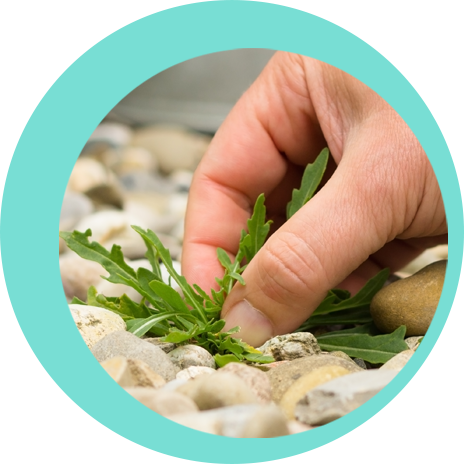





Summer-scaping
We’ve got the essentials for beating the Arizona heat.
Summer’s long, hot dry conditions can test the endurance of many plants. Not to worry, though. We have some simple and inexpensive ways to prepare your landscape for summer’s sizzle – and make sure your plants don’t fizzle. With proper plant care and watering, you can keep your landscape healthy and looking beautiful all year long. Bring it on sun! We are ready for you.
Check Irrigation Systems
Irrigation problems are not always apparent during the cooler times of year, but once summer heat arrives, your system will be providing a lifeline to your plants. Here’s a checklist for some routine maintenance:
- Inspect all components of your watering system, from the backflow preventer to the valves, for standing water, soggy ground, or eroded soil. If you have a controller, check that the programs are correct. If the controller has battery backup power, replace the battery at least yearly.
- Sprinklers should be checked frequently since they are above ground and can easily get damaged or misdirected. Check the irrigation line from the valve to the spray heads for leaks. Replace spray heads if necessary and be sure to replace with the proper spray head. Check that sprinkler heads are flush with the soil surface and straight, not tilted. Clear grass, plants and other obstructions that block sprinkler spray. Finally, adjust sprinkler heads so they don’t spray walls, driveways, or sidewalks.
- For drip irrigation, turn on the system 20-30 minutes before the inspection to allow enough time for emitter wetting patterns to show. Check from the valve to the end of the irrigation line for leaks or clogged emitters. Check for proper emitter placement on plants as they grow. You may need to move emitters out to the drip line of the plant each season. Do this by purchasing some extra micro tubing and connectors.
Adjust Watering Schedules
As the temperature rises, you’ll need to water more frequently. Make sure you water thoroughly and deeply at each watering but allow the soil to dry out between irrigations (days between waterings can reach 30 days or more for some desert plants). By watering this way, roots are encouraged to grow deep into the soil where they’ll be better protected from the summer heat and dryness. To help you determine how much water is needed for your plants, get a free copy of Landscape Watering by the Numbers: A Guide for the Arizona Desert from your city water conservation office or use our interactive Landscape Watering Guide.
Mulch Plant Roots
Landscape plants benefit greatly from organic mulches. When installing new plants, place mulch around the root zone after planting. A two- to four-inch layer of organic mulch will keep roots cooler and will help retain moisture. Organic mulches provide further benefits. They keep weeds in check, improve soil structure, and increase water and nutrient holding abilities for the soil.
If you don’t think organic mulches offer the “desert look” you are after, cover it with granite. To add or replenish mulch to existing plants, simply rake back the rock, add the organic mulch and cover it back up. There is one word of caution: Keep mulches about three to four inches from the trunk or stem, since too much moisture against the bark can cause damage. Because of our high summer temperatures, mulch breaks down very quickly. Therefore, it’s a good idea to replenish organic mulches around existing plants each year.

Remove Weeds
Weeds compete with landscape plants for water and nutrients. The best time to control weeds is before they gain a foothold in your landscape. Pulling weeds is your best strategy. However, there are weed control chemicals that can be applied to prevent weed seeds from germinating, or that can be applied to kill weeds after they’re up and growing.
If weeds are already well established in the landscape, it might be best to remove them with a weeding tool or by hand. When they’re close to maturity, chemical treatment is not as effective. When pulling established weeds, wait until after watering or rain for easier removal and a better chance to get the whole plant – roots and all.
While many weed seeds can be carried into your yard by the wind, birds, or other animals, make sure you don’t seed your own crop. It’s important to remove weeds in the landscape before they flower to prevent seeds from forming and reseeding. Weeds will also germinate when soils are disturbed. After your initial landscape installation, there will likely be weed problems for the first couple of years. After that, keep soil disturbance to a minimum, if possible.
Prune Sparingly
Pruning can enhance the beauty or the health of a plant, but poor pruning can permanently damage it and turn an attractive landscape into an eyesore. If the right-sized plant is planted in an appropriate location (right plant, right place), then little pruning should be necessary.
You may have noticed that plants out in the desert, especially trees, grow low to the ground. When you think about it, this makes sense – the tree is shading itself. Low branches provide shade for the trunk and the roots. The shade also keeps the surrounding soil cooler so moisture will be maintained longer, and litter falls and stays in place providing natural mulch for the plant.
Fertilize Non-Native Plants
Luckily, most of our native desert plants evolved in nutrient-poor soils and are adapted to grow without supplemental fertilizers. Also keep in mind that many nutrients, especially nitrogen, encourage growth and can increase water needs. Consider skipping the fertilizer for native plants. However, non-native plants may need special nutrients to stay healthy in our soils. If this is the case, follow product label recommendations, and only fertilize established plants.
Spring is a good time to fertilize so that nutrients are available as many plants begin more active growth.
Replant Lost Plants
It’s not unusual to lose plants each year. Plants may be living out a natural cycle (especially if they are annuals or perennials). Or there may have been some other stressful situation that caused the plant to decline. Dryness, heat, alkaline soils, and even winter frosts are just some of the conditions that plants have to endure in the Southwest.
When you replace these plants, consider a native plant. Desert plants have special characteristics that help them tolerate tough conditions. Light colored leaves help reflect sunlight to prevent heat buildup. Small or waxy leaves are more water efficient. And succulent stems store water for later use.
By selecting plants that are well adapted to our desert climate, you’ll have less maintenance, save time and money, and be able to enjoy a more attractive landscape. Use these tips for successful plant selection:
- Location, location, location. Check the mature plant size to ensure you are selecting the right plant for the right place. Consider other site conditions. For example, if you have an area with reflected sun, be sure to select a plant that can tolerate extra-hot conditions.
- Group plants with similar water needs to create a landscape that is easier to maintain and is more water efficient. This way, plants will also have less problems with being over- or under-watered.
- Decide what function you want from your plants. You may want a plant for screening, for shade, for color, or to attract wildlife.

